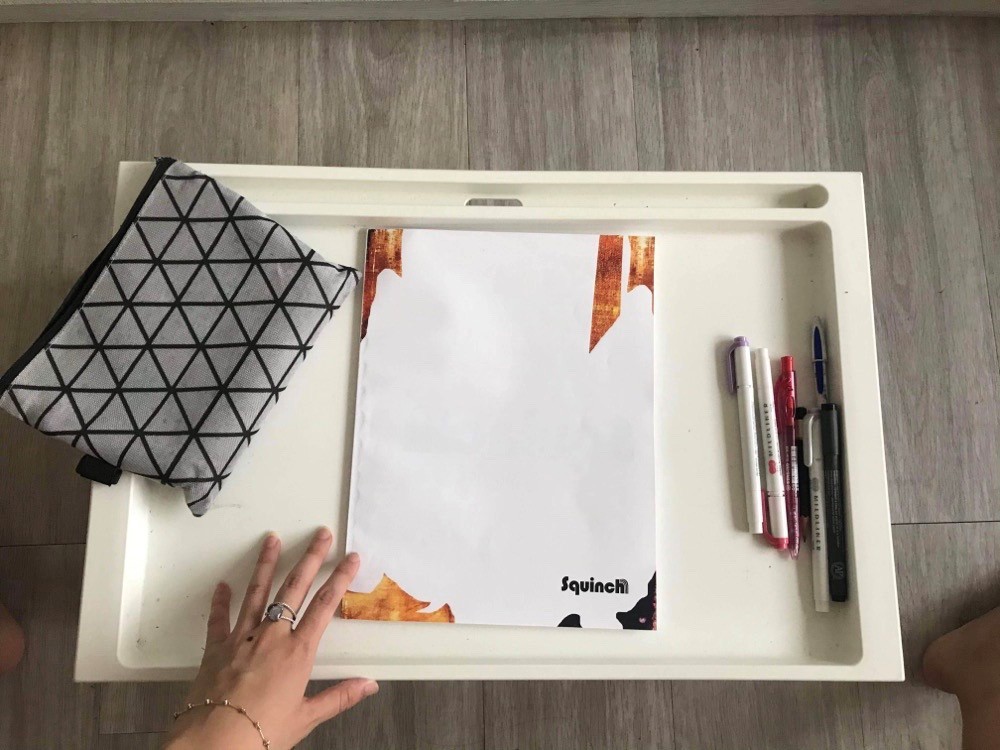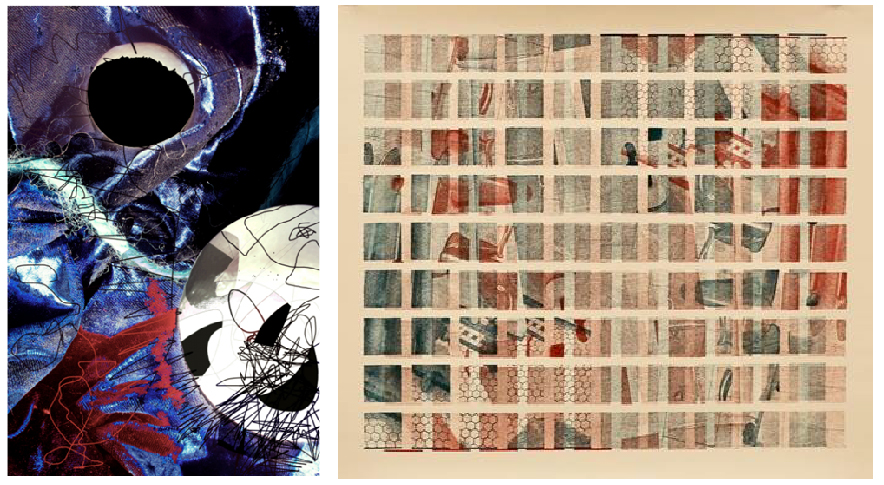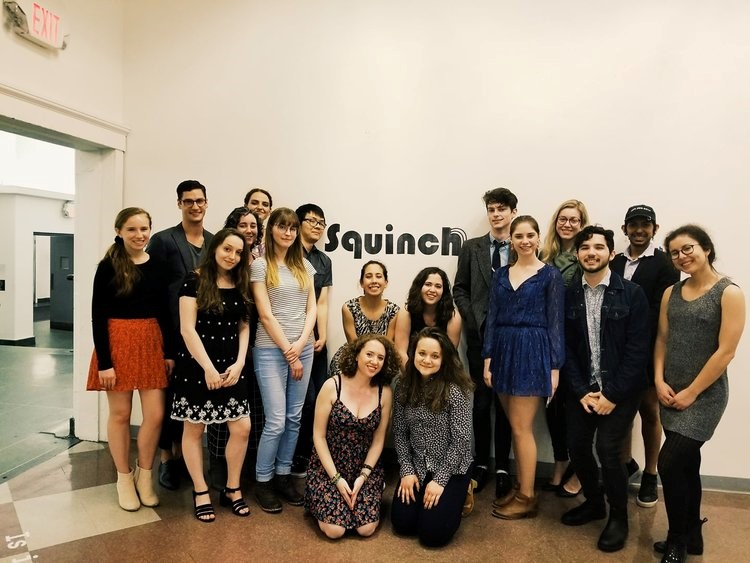
Cover of the latest issue of the magazine. Photo by Cassie Sim.
Four friends who bonded at Orientation, the First-Year Student Outreach Project (FYSOP), and in CFA classes, discovered that they shared a mutual interest in the visual arts and were searching for potential extracurricular activities aimed at discussing art in a non-academic context. When they realized none existed, they decided to start their own; an art magazine called Squinch, where their peers could publish art writing and artwork no matter their program of study.
The summer of 2017, Sofija Chroneos (CFA’20), Kabita Das (CFA’20), Rachel Kubrick (CAS’20), and Olivia Williams (CFA’20, CAS’20) worked tirelessly to create a foundation for the magazine. When they returned to campus that fall, they had already produced their first issue along with a fleshed out website. Positive feedback from their peers and faculty members came pouring in and they realized that Squinch could help fill a gap in creative expression for their fellow students.
Three years and six issues later, the Squinch co-founders are looking back at what they built; a creative community focused on bringing more voices to the arts on campus. Marking their graduation, the four co-founders recently celebrated the release of their final print issue. Squinch now looks to the next generation of undergraduate leaders to continue the magazine’s mission of promoting student voices in the art world.
True to their community-building mission, the Squinch magazine team has decided to donate all proceeds from this issue to Artist Relief, an initiative which supports artists experiencing financial emergencies due to the COVID-19 crisis.
Q (CFA): We understand that the name Squinch came from an Intro to Art History class where you learned how a squinch in architecture holds up the dome. What does this mean for the magazine? Why was this symbolism important to you?
A (Squinch magazine team): The name “Squinch” acts as a metaphor – just as a squinch supports a dome, the magazine supports the collegiate art community. This was important to us because we saw a need to build a platform where one did not exist previously for students interested in the visual arts.
Can you walk us through what putting together an issue of Squinch looks like?
Putting together each issue is a lot of work for our team with several moving parts. For the online issues, we present the work of 5-8 student artists after reviewing our submissions, and include a featured interview by one of our staff writers. Our lead graphic designers also create new pages on the website to showcase the issue. We have definitely streamlined this process, as our first two online issues also included a comic and a new color theme for the entire website.
Creating a print issue, however, requires much more time and even money. The first step is ensuring that we can pay to print the issue, such as through fundraisers or by applying to grants. Next, we review all of our latest art submissions and articles from the past year to determine what we want to highlight in print. Once the content and finances have come together, many hours of design and redesign are necessary to make the issue; this is the most time consuming aspect of running the magazine. We also have to go through each page meticulously before sending it to print. The final step after ordering the issue is to promote it as much as possible, especially through social media.

Sofija Chroneos (CFA’20), Electives IV, digital print, DSLR camera and Photoshop, 2019, 6.5″ x 9″ and Colleen Kinslow (CFA’19, CAS’19), Estrogen Fueled Stupor, woodcut, 2018, 25″ x 24″.
Where do you draw your inspiration for each issue?
Our inspiration for each issue primarily comes from the artwork that we receive. We go through all of our submissions very thoroughly, choosing pieces that we think complement each other the best and show the strengths of each individual artist. In terms of the magazine in general, we were inspired by some of the art publications we admire, such as frieze and especially Hyperallergic.
Who is your primary audience? What do you hope they take away from the publication?
Our primary audience is the collegiate community of students and faculty, especially at BU. However, we have specifically created each issue so that anyone can enjoy the featured articles and artwork, even if they are not based in Boston or involved with undergraduate life. We hope that students reading Squinch will feel empowered, and that readers further along in their art careers will feel inspired by the exciting and relevant work produced by undergraduates.

Article by Daria Lugina (CFA,19, CAS’19) and the latest issue. Photo by Julie O’Brien.
What can you tell us about your most recent issue?
The latest issue acts as a culmination of our work since our first print issue was published in Spring 2018. It features seven writers on topics ranging from Chinese and Western art history to interviews with contemporary artists and curators. We are proud to say that some of the writers have been with us since Squinch’s inception while others became integral to our team more recently. It also includes work by five student artists, ranging from photographers, printmakers, illustrators, and more, two of whom studied at universities outside of BU. We are really excited to have such a diversity of involvement and content.
This issue is also important to us because it is our first charitable initiative, with all proceeds (50% of each purchase) going to Artist Relief. This fund supports artists experiencing financial emergencies due to COVID-19. We look forward to donating our total proceeds in the fall.
How has Squinch evolved since your first issue? What has running Squinch taught you the most over the past three years?
Since our first issue in fall 2017, we have built a dedicated team of student artists and writers, including those outside of BU, and have developed our website and print. We have published four online issues and two print issues over the last three years. Starting a magazine from the ground up at the end of our freshman year was certainly challenging, but with many rewards and lessons along the way.
One of our biggest challenges was recruitment and getting the word out about our magazine. Since we decided to not be affiliated with the Student Activities Office, we could not use their resources such as Splash to do outreach. Instead we relied on social media, word of mouth, and flyers to spread the word. We were also lucky to have the support of many BU departments, including the School of Visual Arts, in our endeavor.
Ultimately, running Squinch has helped us develop academically, professionally, and even personally. As art and art history students, we used the knowledge from our coursework to inform our design and content. On reflecting how her degree in Graphic Design impacted her work with the magazine, co-founder Olivia Williams said, “Countless critiques and creative group projects enabled me to work collaboratively with Squinch. I’ve found that in any organization or collaborative project, being able to navigate working with different work styles and personalities serves your agenda in so many ways.”
Starting a magazine allowed us to apply these skills, from InDesign to writing and editing to working with artists, in a more professional setting. It also provided an opportunity to develop management skills, such as fundraising and marketing. Not only has Squinch shaped our visions of post graduate life and our career paths, but it has facilitated countless connections and friendships for which we are very grateful.

The original 2017-2018 Squinch staff at the launch party for our first print issue.
What does the future of Squinch look like? Where do you hope it goes from here?
Since Squinch was first and foremost about the undergraduate artist and writer, we have decided to end this project with the 2020 print issue, marking our graduation and that of many of our staff. Besides sprucing up the website this summer and continuing to maintain it, we look forward to moving on to new endeavors in the arts and elsewhere.
Rather than continuing Squinch itself, we see the future of the magazine manifesting in its influence on new publications. For example, over the last year we have been advising an emerging arts magazine at Wellesley College, newly on Instagram as @pentimentomag. Furthermore, one of our own writers, Alyssa Goins (CFA’23, CAS’23), is hoping to start an arts newspaper at BU. We can’t wait to see how these projects develop, and feel so proud to pass on this legacy.
If you could describe the experience of Squinch magazine in just one word, what would it be?
Community.
Be sure to check out the latest issue of Squinch magazine featuring writing by Sam Powers (CFA’20), Sophia Yakumithis (CFA’22), Rachel Kubrick (CAS’20), Daria Lugina (CFA’19, CAS’19), Elijah Septoff (CFA’22), Alyssa Goins (CFA’23, CAS’23) and Cassie Sim and artwork by Julia O’Brien, Cassie Sim, Sofija Chroneos (CFA’20, ’21), Vivian Myron and Colleen Kinslow (CFA’19, CAS’19).